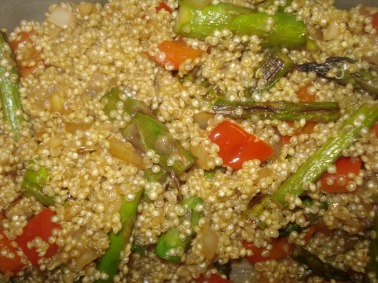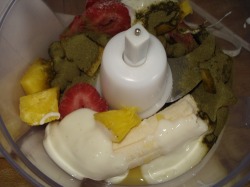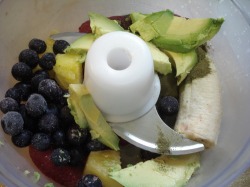When it comes to coffee, I've always been a "cream, no sugar...thanks" coffee drinker. At a brunch with friends, I watched one scoop a big spoonful of honey from the jar and stir it into her cup of coffee. What?! It seemed so wrong, but as I found out, tastes oh-so good.
I've been using raw, creamed honey and stirring an entire spoonful of the sweet, solid substance into my cup of coffee every morning. Choosing raw honey over sugar gives the benefit of an unprocessed sweetener and beyond that, raw honey has antibacterial properties and never spoils.
Make an extra tasty cup of coffee by adding cinnamon to the grounds before brewing, and then stirring a spoonful of honey into your coffee. Mmm!
For the past few weeks, I have been eating the Amazing Grass Berry Green SuperFood mixed with yogurt. I stepped it up a notch and have been making fruit smoothies with my awesome new food processor (I love this appliance so much!).
After seeing pineapples for only $2.50 (!) at the produce market a couple blocks from my house, I bought one and stared at it every day, impatiently waiting for it to ripen. When the time had come, I sliced it up and started adding it to my morning blends.
My first smoothie contained half a banana (fair trade and organic), frozen strawberries and blueberries, pineapple, orange juice, organic vanilla yogurt and a scoop of Berry Green SuperFood.
For my next smoothie, I decided to exclude dairy, and instead substituted half an avocado. It also included half a banana, frozen strawberries, frozen blueberries, orange juice and a scoop of Berry Green SuperFood. The avocado was great. The texture is smooth and the taste mild enough that it easily mixes in with the other ingredients and adds the creaminess of yogurt.
As an environmental awareness plug, I strongly advocate using locally in-season produce. Fruit gets a little difficult because so many of the fruits we love come from tropical climates. I try to do the best I can by carefully choosing the lesser of all evils. I purchase organic, fair trade bananas at my co-op which ensures that the growing process is as easy on the land as possible (shipping is still an issue, since they're from Central America). While berries are starting to show up in stores, they're not local berries. Our crops won't be ready until late summer, and I will happily wait to be able to enjoy those delicious berries. Instead I'm buying frozen berries which were picked in-season. They're not losing any significant amount of nutritional value by being frozen. Most of these early season berries don't have a lot of flavor and can have gross textures...think of all the miles these delicate fruits travel in trucks! As for the pineapple and avocados, I do buy the conventional versions of both fruits. Organic options for those are often very sparse, and the prices are a little out of my range. While I sometimes wish I could buy more organic or local products, I'm happy for now that I do what I can in at least supporting some of those options.



 RSS Feed
RSS Feed